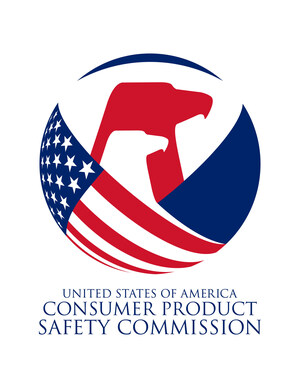WASHINGTON, Dec. 5, 2013 /PRNewswire-USNewswire/ -- The U.S. Consumer Product Safety Commission (CPSC) estimates there were 15,000 injuries involving holiday decorating seen in emergency departments nationwide during November and December 2012. This is the fourth consecutive year these estimates have increased. In each year since 2009, there have been an estimated 12,000 or more emergency department visits. Falling from a ladder and stepping on broken ornaments may be funny in holiday movies but in real life, these and similar mishaps result in visits to the emergency room, or calls to fire departments, for thousands of consumers each year.
(Logo: http://photos.prnewswire.com/prnh/20030904/USCSCLOGO)
"There are about 250 injuries a day during the holiday season. Adding safety to your checklist can keep a holiday tradition from becoming a holiday tragedy," said CPSC Acting Chairman Robert Adler. "Keep Christmas trees watered well, don't leave candles unattended, and use caution whenever you are on a ladder."
In 2012, the most frequently reported holiday decorating incidents seen in emergency departments involved falls (34%), lacerations (11%) and back strains (10%). When it comes to fires, from 2009 through 2011, fire departments nationwide responded to an average of 200 fires in which the Christmas tree was the first item ignited. These incidents resulted in 10 deaths, 20 injuries and $16 million in property loss. In addition, candle-related fires from 2009 through 2011 have resulted in an estimated 70 deaths, 680 injuries and $308 million in property loss.
To prevent fires, discard holiday lights sets with evidence of damage such as broken sockets and bare wires, water Christmas trees frequently, and always extinguish candles before leaving a room.
Consumers can use the following safety tips as a guide to help prevent decorating disasters this holiday season:
Ladders
1. Heed the warning labels on ladders. Read CPSC's OnSafety blog, "Ladder Safety 101," for tips to prevent ladder falls this season.
Trees and Decorations
1. Buying a live tree? Check for freshness. A fresh tree is green, its needles are hard to pull from branches, and the needles do not break when bent between your fingers. The bottom of a fresh tree is sticky with resin, and when tapped on the ground, the tree should not lose many needles.
2. Setting up a tree at home? Place it away from heat sources, such as fireplaces, vents, and radiators. Because heated rooms rapidly dry out live trees, be sure to monitor water levels daily, and keep the tree stand filled with water. Place the tree out of the way of foot traffic, and do not block doorways with the tree.
3. Buying an artificial tree? Look for the label: "Fire Resistant." Although this label does not mean that the tree will not catch fire, the label does indicate that the tree is more resistant to catching fire.
4. Decorating a tree in a home with small children? Take special care to avoid sharp, weighted, or breakable decorations. Keep trimmings with small removable parts out of the reach of children, who could swallow or inhale small pieces. Avoid trimmings that resemble candy or food that may tempt a child to reach for and swallow them.
Candles
1. Keep burning candles within sight. Extinguish all candles before you go to bed, leave the room, or leave the house.
2. Keep candles on a stable, heat-resistant surface. Place candles where kids and pets cannot reach them or knock them over. Lighted candles should be placed away from items that can catch fire, such as trees, other evergreens, decorations, curtains and furniture.
Lights
1. Use lights that have been tested. Select lights tested for safety by a nationally recognized testing laboratory, such as Underwriters Laboratories (UL), Intertek (ETL) or the Canadian Standards Association (CSA). Lights for both indoor and outdoor use must meet strict requirements that testing laboratories are able to verify. On decorative lights available in stores, UL's red holographic label signifies that the product meets safety requirements for indoor and outdoor use. UL's green holographic label signifies that the product meets requirements for indoor use only.
2. Check each set of lights. Examine new and old lights for broken or cracked sockets, frayed or bare wires, or loose connections. Throw out damaged sets, and do not use electric lights on a metallic tree.
3. Check each extension cord. Make sure each extension cord is rated for the intended use and is in good condition. Do not use cords with cuts or signs of fraying.
4. Check outdoor lights for labels. Look for labels indicating that the lights have been certified for outdoor use, and only plug them into a ground-fault circuit interrupter (GFCI)-protected receptacle or a portable GFCI.
Fireplaces
1. Use care with "fire salts." Fire salts produce colored flames when thrown onto wood fires. Fire salts contain heavy metals that can cause intense gastrointestinal irritation and vomiting, if swallowed. Keep fire salts away from children.
2. Do not burn wrapping papers in the fireplace. A flash fire may result from burning wrapping papers because wrappings can ignite suddenly and burn intensely.
Media Contact
Please use the phone numbers below for all media requests.
Phone: (301) 504-7908
Spanish: (301) 504-7800
CPSC Consumer Information Hotline
Use this toll-free number if you have questions about a recall:
800-638-2772 (TTY 301-595-7054)Times: 8 a.m. – 5:30 p.m. ET;
Messages can be left anytime. Hotline can be used to get product safety and other agency information and to report unsafe products.
SOURCE U.S. Consumer Product Safety Commission
WANT YOUR COMPANY'S NEWS FEATURED ON PRNEWSWIRE.COM?
Newsrooms &
Influencers
Digital Media
Outlets
Journalists
Opted In





Share this article